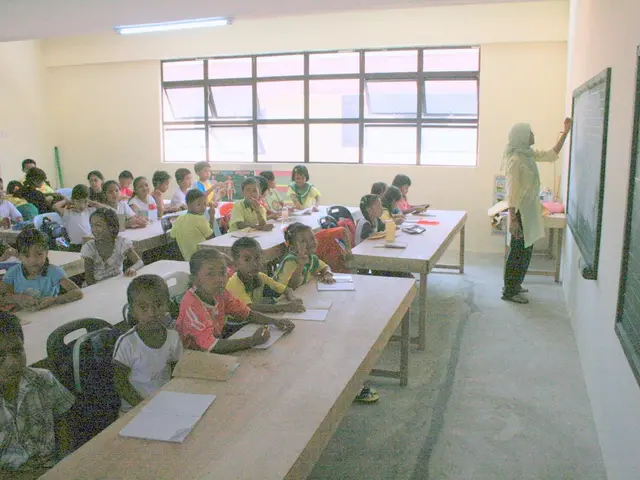Future of Online Education: Anticipated Developments by 2025
**Top Interactive eLearning Trends and Best Practices for 2024 and Beyond**
In the ever-evolving world of education, eLearning continues to revolutionize the way we acquire knowledge. Here are the top interactive eLearning trends and best practices that are shaping the future of online learning.
**1. AI-Driven Personalization**
Artificial Intelligence (AI) is playing a significant role in eLearning, with AI-powered Learning Paths becoming increasingly common. These personalized learning paths adapt to students' strengths, weaknesses, and learning pace, ensuring a tailored educational experience. AI chatbots also serve as tutors, offering 24/7 support, and aiding in analyzing student data, lesson creation, and automatic grading.
**2. Virtual Reality (VR) and Augmented Reality (AR)**
VR and AR are transforming eLearning by providing immersive experiences. Virtual labs, AR overlays for equipment maintenance tutorials, and realistic field trips are just a few examples of how these technologies are revolutionizing education. The AR and VR market is expected to surpass $209 billion in 2025, significantly benefiting the education sector.
**3. Video-Based Learning**
Video-based learning is becoming an integral part of digital learning strategies, with 98% of organizations planning to implement video in their courses. Cloud-based platforms make integration easier, and videos cater well to visual learners, making learning more engaging and accessible.
**4. Collaborative Learning Environments**
Collaborative learning environments foster interaction and engagement, promoting a sense of community and shared learning experiences. This trend enhances student interaction, making online learning more social and dynamic.
**5. Adaptive Learning Technologies**
Adaptive technologies use AI to assess learner progress and adjust content complexity in real-time, ensuring that learning is optimized for each individual. This personalized approach to education ensures that students learn at their own pace and in a way that suits their learning style.
**6. Hybrid Programs and Micro-Credentials**
Hybrid programs and micro-credentials offer students flexible, stackable credentials that can be applied toward full degrees. This trend allows learners to tailor their education to their career goals more efficiently.
**7. Mobile-First Platforms**
Mobile-first platforms enable students to complete courses on-the-go, with studies showing that mobile users complete lessons up to 45% faster than desktop users. These platforms enhance accessibility and convenience, making learning more adaptable to modern lifestyles.
**Best Practices for eLearning Development**
- Design with the Learner in Mind: Ensure that courses are learner-centric, taking into account age, expertise, and learning preferences. - Leverage Data Analytics: Use data analytics to continuously improve learning outcomes and refine content based on learner feedback. - Emphasize Experiential Learning: Incorporate experiential elements to make learning more engaging and practical.
The global eLearning market is expected to reach a record high of $1 trillion by 2032. In 2024, AI-powered learning platforms are expected to analyze learners' unique needs, curate hyper-targeted and result-oriented curriculums, and automate repetitive tasks for educators. Augmented Reality (AR) and Virtual Reality (VR) technologies will enable educators to create practical learning environments, allowing for realistic field trips and expeditions from the classroom.
Nano Learning, or microlearning, will become prevalent, focusing on delivering small, manageable chunks of content optimized for mobile devices like smartphones and tablets. Virtual Instructor-Led Training (VILT) will make a significant comeback in 2024, facilitating education for distant students through live sessions, video conferences, and other interactive means. Learning Experience Platforms (LXPs) will emerge as an enhanced alternative to Learning Management Systems (LMS), offering personalized content and gamification elements to optimize the learning experience.
In the coming years, digital textbook platforms will enable educators and educational institutions to produce creative, dynamic eLearning materials, such as eBooks and digital textbooks. Blended Learning will see a resurgence in 2024, combining virtual and in-person teaching to create an engaging and convenient learning experience. AI is expected to be a key trend in eLearning in 2024, with AI-powered learning platforms promoting personalized learning. AR and VR are anticipated to be significant trends in eLearning, providing immersive learning experiences.
The landscape of digital learning is expected to expand further, becoming more convenient, synergistic, and inclusive. The future of learning is predicted to be online.
Technology and Artificial Intelligence (AI) are playing a significant role in education, particularly eLearning. In 2024, AI-powered learning platforms are expected to analyze learners' unique needs, curate hyper-targeted and result-oriented curriculums, and automate repetitive tasks for educators.
The use of Augmented Reality (AR) and Virtual Reality (VR) in education is anticipated to be a significant trend, providing immersive learning experiences such as virtual labs, AR overlays for equipment maintenance tutorials, and realistic field trips. These technologies are transforming the way we acquire knowledge and facilitating a revolution in online learning.




